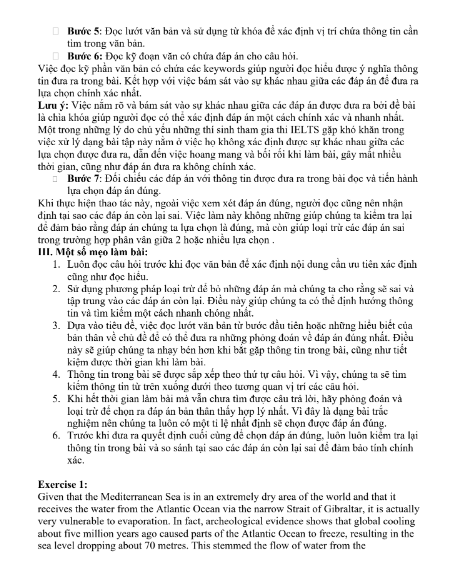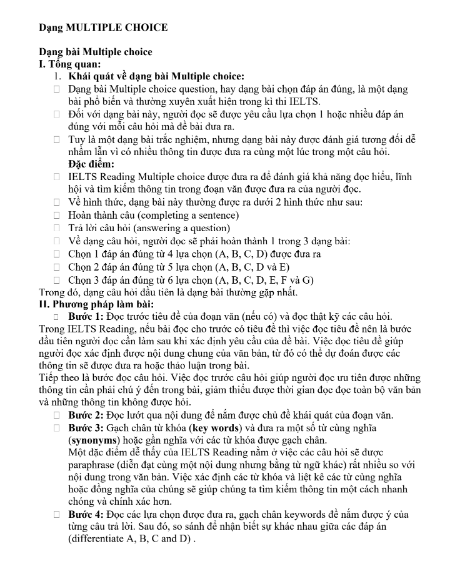


DẠNG MULTIPLE CHOICE
I. TỔNG QUAN
1. Khái quát về dạng bài Multiple Choice
- Dạng bài Multiple choice question (chọn đáp án đúng) là một dạng bài phổ biến và thường xuyên xuất hiện trong kì thi IELTS.
- Người đọc được yêu cầu lựa chọn một hoặc nhiều đáp án đúng cho mỗi câu hỏi mà đề bài đưa ra.
- Tuy là dạng trắc nghiệm, nhưng dạng này dễ nhầm lẫn vì có nhiều thông tin xuất hiện cùng lúc trong một câu hỏi.
Đặc điểm:
- IELTS Reading Multiple Choice đánh giá khả năng đọc hiểu, lĩnh hội và tìm kiếm thông tin trong đoạn văn.
- Dạng bài thường có 2 hình thức:
- Hoàn thành câu (Completing a sentence)
- Trả lời câu hỏi (Answering a question)
- Các dạng câu hỏi có thể yêu cầu:
- Chọn 1 đáp án đúng từ 4 lựa chọn (A, B, C, D)
- Chọn 2 đáp án đúng từ 5 lựa chọn (A–E)
- Chọn 3 đáp án đúng từ 6 lựa chọn (A–G)
→ Dạng chọn 1 đáp án đúng là phổ biến nhất.
II. PHƯƠNG PHÁP LÀM BÀI
Bước 1: Đọc tiêu đề của đoạn văn (nếu có) và câu hỏi
- Tiêu đề giúp xác định nội dung chung của bài đọc.
- Đọc trước câu hỏi giúp xác định thông tin cần tìm, tránh lãng phí thời gian đọc toàn văn.
Bước 2: Đọc lướt để nắm được chủ đề khái quát của đoạn.
Bước 3: Gạch chân từ khóa (keywords) và liệt kê các từ đồng nghĩa / gần nghĩa (synonyms).
- Các câu hỏi IELTS Reading thường paraphrase (diễn đạt lại).
- Việc xác định và mở rộng từ khóa giúp tìm thông tin nhanh và chính xác.
Bước 4: Đọc kỹ các lựa chọn (A, B, C, D)
- Gạch chân keywords trong từng đáp án.
- So sánh sự khác nhau giữa các lựa chọn để tránh nhầm lẫn.
Bước 5: Đọc lướt văn bản và dùng từ khóa để xác định vị trí thông tin trong đoạn.
Bước 6: Đọc kỹ đoạn chứa đáp án
- Hiểu rõ ngữ cảnh, ý nghĩa thông tin và đối chiếu với các lựa chọn.
- Chú ý phân biệt điểm khác nhau giữa các đáp án.
Lưu ý:
Việc xác định rõ điểm khác biệt giữa các lựa chọn là chìa khóa giúp chọn đáp án đúng và nhanh nhất.
Nhiều thí sinh mất điểm vì không thấy được sự khác biệt nhỏ giữa các lựa chọn.
Bước 7: Đối chiếu và chọn đáp án đúng
- Kiểm tra tại sao đáp án còn lại sai → giúp củng cố chắc chắn lựa chọn của mình.
III. MỘT SỐ MẸO LÀM BÀI
- Đọc câu hỏi trước khi đọc văn bản.
- Dùng phương pháp loại trừ để loại bỏ các đáp án sai.
- Dự đoán đáp án dựa trên tiêu đề hoặc hiểu biết trước đó.
- Thông tin trong bài được sắp xếp theo thứ tự câu hỏi.
- Khi hết thời gian, hãy phỏng đoán – luôn có xác suất đúng.
- Kiểm tra lại lý do các đáp án sai trước khi chọn cuối cùng.
EXERCISE 1
Đoạn 1: The Mediterranean Sea
Given that the Mediterranean Sea is in an extremely dry area of the world and that it receives the water from the Atlantic Ocean via the narrow Strait of Gibraltar, it is actually very vulnerable to evaporation. In fact, archeological evidence shows that global cooling about five million years ago caused parts of the Atlantic Ocean to freeze, resulting in the sea level dropping about 70 metres. This stemmed the flow of water from the Mediterranean received. At the same time, the movement of tectonic plates resulted in Europe and Africa drawing closer to one another. This raised the land high enough to further block the Mediterranean from the Atlantic Ocean. It was not long before the warm water remaining in the Mediterranean Sea began to vanish, leaving behind nothing but salt.
Câu hỏi:
- What is said about the Strait of Gibraltar?
A. It has a maximum depth about 70 metres
B. It froze over during an era of global cooling
C. It evaporated due to tectonic plate movement
D. It conveys water from the ocean into the sea - What diminished the amount of water the Mediterranean Sea received from the Atlantic Ocean?
A. A period of dry water
B. A sea level reduction
C. A blockage of ice
D. A rise in temperature
| Từ vựng | Nghĩa tiếng Việt | Phiên âm |
|---|---|---|
| Mediterranean Sea | Biển Địa Trung Hải | /ˌmedɪtəˈreɪniən/ |
| Via (prep) | Thông qua | /ˈvaɪə/ |
| Vulnerable (a) | Dễ bị tổn thương | /ˈvʌlnərəbl/ |
| Evaporation (n) | Sự bay hơi | /ɪˌvæpəˈreɪʃn/ |
| Archaeological (adj) | Thuộc khảo cổ học | /ˌɑːkiəˈlɒdʒɪkl/ |
| Stem (v) | Ngăn chặn | /stem/ |
| Tectonic plate | Mảng kiến tạo | /tekˈtɒnɪk/ |
| Vanish (v) | Biến mất | /ˈvænɪʃ/ |
| Atlantic Ocean | Đại Tây Dương | /ətˈlæntɪk/ |
Đoạn 2: Ancient Greece
In Ancient Greece, the prevailing religious traditions centred around Dionysus… (nguyên văn giữ nguyên như bạn gửi)
Câu hỏi:
- According to the writer, the Ancient Greek wine tasting festival held each fall involved
A. the performance of poetry
B. the production of wine
C. the harvesting of corn
D. the visiting of temples - The movement of plays from the religious world to the general public caused
A. a protest against organised religions across Europe
B. the collapse of the ancient Greek civilisation
C. an increase in the general public’s curiosity about art
D. some actors to become critical of social classes
EXERCISE 2
Đoạn 3: The Discovery of Penicillin
In 1928, Alexander Fleming, a Scottish bacteriologist, made one of the most important medical discoveries in history by accident. While experimenting with bacteria cultures at St. Mary’s Hospital in London, he noticed that one of his petri dishes had been contaminated with a mould, and that the bacteria surrounding the mould had died. Fleming identified the mould as Penicillium notatum and later realised that it produced a substance capable of killing many types of harmful bacteria. This substance was named penicillin. Although Fleming published his findings, it took more than a decade before other scientists managed to extract and mass-produce the drug during World War II.
Câu hỏi:
- What was unusual about Fleming’s discovery?
A. It was the result of a failed experiment
B. It happened during a medical competition
C. It was entirely accidental
D. It relied on a new bacterial theory - What was the main difficulty after Fleming’s discovery?
A. The lack of hospital facilities
B. The inability to isolate the substance
C. The destruction of samples in the war
D. The loss of research funding
| Từ vựng | Nghĩa tiếng Việt | Phiên âm |
|---|---|---|
| Bacteriologist | Nhà vi khuẩn học | /bækˌtɪəriˈɒlədʒɪst/ |
| Petri dish | Đĩa nuôi cấy vi khuẩn | /ˈpiːtri dɪʃ/ |
| Contaminate (v) | Làm nhiễm bẩn | /kənˈtæmɪneɪt/ |
| Mould (n) | Nấm mốc | /məʊld/ |
| Extract (v) | Chiết xuất | /ɪkˈstrækt/ |
| Mass-produce (v) | Sản xuất hàng loạt | /ˌmæs prəˈdjuːs/ |
EXERCISE 3
Đoạn 4: The Origins of the Internet
The Internet began as a research project funded by the United States Department of Defense in the late 1960s. The original purpose was to create a communication system that could survive a potential nuclear attack by distributing data across a network rather than relying on a single central hub. This network, called ARPANET, connected computers at several universities and research centres. Over time, more institutions joined, and protocols were developed to allow computers to share information more easily. By the 1990s, the Internet had expanded globally, transforming communication, business, and education forever.
Câu hỏi:
- Why was ARPANET initially developed?
A. To enable instant global communication
B. To connect military bases directly
C. To withstand possible wartime damage
D. To replace telephone networks - What happened after ARPANET expanded?
A. It was restricted to military use
B. It became a worldwide system
C. It was shut down by universities
D. It lost government funding
| Từ vựng | Nghĩa tiếng Việt | Phiên âm |
|---|---|---|
| Department of Defense | Bộ Quốc phòng (Mỹ) | /dɪˈfens/ |
| Nuclear attack | Cuộc tấn công hạt nhân | /ˈnjuːkliə(r)/ |
| Hub (n) | Trung tâm, nút mạng | /hʌb/ |
| Protocol (n) | Giao thức, quy ước truyền dữ liệu | /ˈprəʊtəkɒl/ |
| Expand (v) | Mở rộng | /ɪkˈspænd/ |
| Transform (v) | Biến đổi | /trænsˈfɔːm/ |
EXERCISE 4
Đoạn 5: The Great Fire of London
In September 1666, a massive fire swept through the city of London, destroying over 13,000 houses and 87 churches, including St. Paul’s Cathedral. The fire started in a bakery on Pudding Lane and spread rapidly due to wooden buildings and strong winds. Although only a few people lost their lives, the destruction was immense, leaving most of the city’s residents homeless. The disaster led to major changes in building regulations and city planning, with new laws requiring houses to be built from brick and stone to prevent such a tragedy from happening again.
Câu hỏi:
- What was the main reason the fire spread so quickly?
A. The bakery contained flammable materials
B. The houses were built close together and made of wood
C. There was a delay in firefighting response
D. The city had few escape routes - What was one positive result of the Great Fire?
A. London developed new safety laws
B. St. Paul’s Cathedral was saved
C. People moved to rural areas
D. Wooden homes became more popular
| Từ vựng | Nghĩa tiếng Việt | Phiên âm |
|---|---|---|
| Sweep through | Càn quét, lan rộng | /swiːp θruː/ |
| Destruction (n) | Sự tàn phá | /dɪˈstrʌkʃn/ |
| Regulation (n) | Quy định | /ˌreɡjuˈleɪʃn/ |
| Cathedral (n) | Nhà thờ lớn | /kəˈθiːdrəl/ |
| Flammable (a) | Dễ cháy | /ˈflæməbl/ |
EXERCISE 5
Đoạn 6: Renewable Energy
Renewable energy sources, such as solar, wind, and hydro power, have become increasingly important as the world seeks to reduce its dependence on fossil fuels. Solar panels convert sunlight into electricity, while wind turbines harness the power of moving air. Hydroelectric dams generate energy from flowing water. Although renewable sources are environmentally friendly, they can be expensive to install and may depend on weather conditions. Nevertheless, with technological advances, renewable energy is expected to play a major role in achieving a sustainable future.
Câu hỏi:
- What is a disadvantage of renewable energy mentioned in the passage?
A. It causes environmental pollution
B. It requires a lot of fossil fuel to operate
C. It can be costly and weather-dependent
D. It damages natural habitats - What is the writer’s attitude toward renewable energy?
A. Negative
B. Cautiously optimistic
C. Indifferent
D. Highly critical
| Từ vựng | Nghĩa tiếng Việt | Phiên âm |
|---|---|---|
| Renewable (a) | Có thể tái tạo | /rɪˈnjuːəbl/ |
| Fossil fuel | Nhiên liệu hóa thạch | /ˈfɒsl ˈfjuːəl/ |
| Harness (v) | Khai thác, tận dụng | /ˈhɑːnɪs/ |
| Sustainable (a) | Bền vững | /səˈsteɪnəbl/ |
| Weather-dependent | Phụ thuộc thời tiết | /ˈweðə dɪˈpendənt/ |



